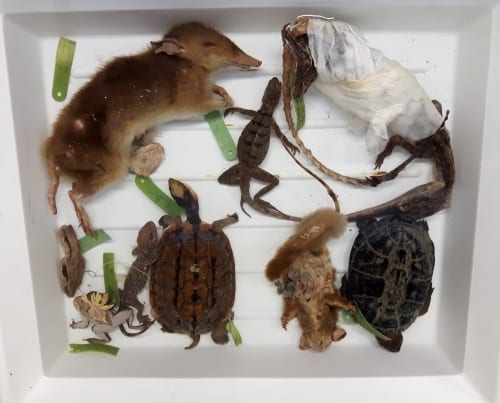Specimen of the Week 280: Preserved Gharial
By Tannis Davidson, on 24 February 2017
Over the past year, UCL Culture’s conservation team has been undertaking work on a project to conserve many of the Grant Museum’s specimens which are preserved in fluid (read more about ‘Project Pickle’ here). During the ongoing work, specimens have been re-hydrated, remounted, rehoused and re-identified.
Along the way there have also been some new discoveries of specimens that we didn’t know were in the collection. Some of the jars were full of fluid so discoloured that it was impossible to see the animal inside and it was only when the specimen was taken out that the identification could be made. One jar had an astounding 11 different animals inside including this week’s Specimen of the Week…
**The Preserved Gharial**
This juvenile Gavialis gangeticus is a welcome ‘addition’ to the Grant Museum. G. gangeticus , commonly known as the gharial or gavial, is one of only two extant species (along with the so-called false gharial Tomistoma schlegelii) in family Gavialidae. They are only found in three rivers in India (Chambal River, Girwa River and Son River) and one in Nepal (Rapti/Narayani River) 1. In the most recent IUCN Red List of Threatened Species assessment of this species in 2007, G. gangeticus is listed Critically Endangered based on both chronic long term and rapid short term declines with an estimated population of fewer that 250 individuals in the wild. 2.
The Museum has a few gharials in the collection but they are all skeletal apart from one very shriveled taxidermy specimen. This specimen, now the sole preserved gharial specimen in the Grant Museum, is in a good condition despite its formerly cramped conditions, a dissected belly and some scale loss on the tail. Overall, it is a useful specimen to illustrate the species’ characteristic long, narrow snout (with perfect dentition), smooth epidermal non-overlapping body scales and dorsal osteoderms (bony plates).
It likely came to the Grant Museum from the London Zoo sometime in the 1960’s together with a number of other specimens which at some point had been preserved in the same jar. While we have many preserved specimens of multiple individuals in the collection, they are usually of the same or related species, often remnants from dissection labs or research collections. In this jar however, it was a veritable potpourri of animals:
Removed from the jar were (clockwise from top left in image above): long-nosed bandicoot, Russell’s viper (head only – below belly of bandicoot), banded basilisk, gharial (wrapped in tissue), terrapin, squirrel glider, side necked turtle, brindled house gecko, Gunther’s frog, Boa constrictor (head) and a Southern three-banded armadillo (not pictured).
Following transfer out of the communal jar, each specimen was individually rehoused in a new jar with fresh 80% IMS (Industrial methylated spirit – alcohol used for preservation), ensuring their preservation for many years to come.
Thus following this decant, the Grant Museum now has 11 new specimens suitable for display and with the potential to be used in teaching, research, family learning activities and more.
Tannis Davidson is the Acting Curator at the Grant Museum of Zoology
References
- , 2. IUCN Redlist http://www.iucnredlist.org/details/8966/0
3 Responses to “Specimen of the Week 280: Preserved Gharial”
- 1
- 2
-
3
Lisa Randisi wrote on 13 May 2020:

Hi Riju. You can find more pictures of the gharial, and our other specimens, on our online catalogue: http://gmzcat.museums.ucl.ac.uk/
 Close
Close






I gotta bookmark this web site it seems very beneficial very beneficial.